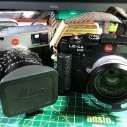Old vs new lens
-
Recently Browsing 0 members
- No registered users viewing this page.
-
Similar Content
-
- 19 replies
- 937 views
-
- 12 replies
- 1,581 views
-
- 20 replies
- 697 views
-
- 3 replies
- 274 views
-
- 6 replies
- 299 views
-





Recommended Posts
Join the conversation
You can post now and register later. If you have an account, sign in now to post with your account.
Note: Your post will require moderator approval before it will be visible.